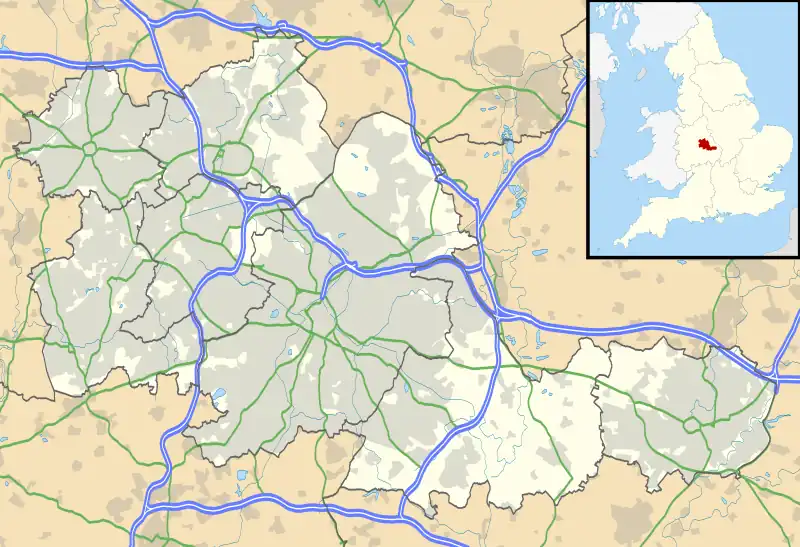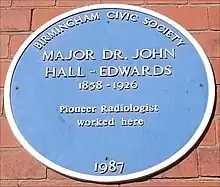| Birmingham General Hospital | |
|---|---|
 The Steelhouse Lane building in November 2010 | |
 Shown in West Midlands | |
| Geography | |
| Location | Birmingham, England |
| Coordinates | 52°29′5.1″N 1°53′38″W / 52.484750°N 1.89389°W |
| Organisation | |
| Care system | NHS |
| Type | Teaching |
| Services | |
| Emergency department | Yes |
| Helipad | Yes |
| History | |
| Opened | 1779 |
| Closed | c. 1995 |
| Links | |
| Lists | Hospitals in England |
Birmingham General Hospital was a teaching hospital in Birmingham, England, founded in 1779 and closed in the mid-1990s.
History
Summer Lane



In 1765, a committee for a proposed hospital, formed by John Ash and supported by Sir Lister Holte, 5th Baronet, the Earl of Bradford, Samuel Garbett, Sir Henry Gough, Charles Adderley, Matthew Boulton, John Baskerville, Sampson Lloyd and others,[1] purchased:
all those four closes, pieces, or parcels of Land, Meadow, or Pasture Ground, situate, lying, and being together near a place called the Salutation, in Birmingham aforesaid, containing, by estimation, eight Acres or thereabouts, be the same more or less, adjoining at the upper end or part thereof into a Lane there called Summer Lane, and at the lower end or part thereof unto a way called Walmore Lane
from a Mrs Dolphin, for £120 per acre.[1][2] (Walmore Lane is now Lancaster Street.)[2] However, work to erect the new hospital on that land stopped through lack of funds in 1766.[1] Eventually, much of its funds came from the Birmingham Triennial Music Festival, the first of which was held over three days in September 1768,[3] and which continued to fund the hospital into the 20th century.[3]
The hospital finally opened on 20 September 1779,[1][4][5] giving its name to Hospital Street.[2] About 200 patients were treated in its first three months of operation,[5] even though the 40 beds were fewer than half those aimed for.[1] Two, two-storey side wings were added in 1790.[6] Further extensions were made in 1857 and 1880.[6] Eventually 235 beds were provided on the site.[1] The site was later used for a tram, then bus, depot and is now occupied by Centro House, headquarters of the Transport for West Midlands, where there is a blue plaque (at 52°29′15″N 1°53′59″W / 52.487475°N 1.899811°W) commemorating the hospital.[7]
Steelhouse Lane

The hospital relocated to Steelhouse Lane in 1897,[1][5] on a site formerly occupied by almshouses provided by Lench's Trust.[6] The architect of the new, brick building was William Henman.[8] Neville Chamberlain became an Official Visitor and then a director of the hospital. He advocated a larger facility, a cause in which he was eventually successful, though building did not commence until 1934. He was still fundraising while he was Prime Minister.[9]
The hospital became part of the new National Health Service in 1948.[10] Until 1964 the hospital was a training centre for nurses, who, on qualification, became members of the General Hospital Birmingham Nurses League.[11] After 1964, training switched to Queen Elizabeth Hospital in the nearby suburb of Edgbaston.[11] The league was wound up in 2000, due to its remaining members' increasing age.[11]
The Birmingham pub bombings, the worst terrorist attack on the mainland until 2005, occurred within a mile of the hospital, on 21 November 1974. Taxi cabs and all available ambulances ferried victims to either the General or to the nearby Accident Hospital.[12]
After Birmingham General Hospital closed in the mid-1990s, the main red brick building was adapted for use as Birmingham Children's Hospital which opened there in 1998.[13]
Notable staff

- John Ash (1723–1798)[1]
- Richard Lindsey Batten (1920–1997)
- Sir William Bowman, 1st Baronet (1816–1892)
- Sir Thomas Frederick Chavasse (1854 - 1913)
- Balthazar Foster, 1st Baron Ilkeston (1840–1913)
- George Freer (founder of the city's Orthopaedic Hospital)[1]
- Sampson Gamgee (1828–1886)
- John Hall-Edwards (1858–1926)
- Joseph Hodgson (1788–1869)[1]
- John Johnstone (1801–1833)[14]
- Robert Mills-Roberts (1862–1935)
- Dame Ellen Musson (1867–1960)
- Arthur Thomson (1890–1977)
- William Withering (1741–1799)[1]
Notable births
- Bert Harris (1873–1897), professional racing cyclist
Notable deaths
- Arthur Lowe (1915-1982), Dad’s Army actor, best known for his role as Captain George Mainwaring, who died there aged 66 following a stroke[15]
Archives
Archives related to Birmingham General Hospital are held at the Cadbury Research Library, University of Birmingham.[16][17]
Arms
 |
|
Notes
- 1 2 3 4 5 6 7 8 9 10 11 "Ash's deed for our General wellbeing". Birmingham Mail. 20 February 2010. Archived from the original on 10 June 2014. Retrieved 28 July 2012.
- 1 2 3 "Garden of Eden in Summer Lane". Birmingham Mail. 12 April 2008. Archived from the original on 28 March 2015. Retrieved 28 July 2012.
- 1 2 Elliott, Anne (2000). The Music Makers - a Brief History of the Birmingham Triennial Music Festivals 1784 - 1912. Birmingham City Council. ISBN 978-0-7093-0224-7.
- ↑ Wilson, Adrian (2002), "The Birmingham General Hospital and its Public, 1765–79", in Sturdy, Steve (ed.), Medicine, Health and the Public Sphere in Britain, 1600–2000, Routledge Studies in the Social History of Medicine, vol. 16, London: Routledge, pp. 90–91, ISBN 978-0-415-27906-2
- 1 2 3 "Expressions of care; A new book has been published on the history of hospitals in Birmingham. Chris Upton delves into its pages". Birmingham Post. 19 August 2010.
- 1 2 3 Thornton, Roy (2009). Lost Buildings of Birmingham. The History Press. p. 75. ISBN 978-0750950992.
- ↑ Plaque #1565 on Open Plaques
- ↑ Lerum, Vidar (2015). Sustainable Building Design: Learning from nineteenth-century innovations. Routledge. p. 128. ISBN 9781317566458.
- ↑ "Look: 30 nostalgic images take you back down the corridors of Birmingham's old hospitals". Birmingham Mail. 1 August 2014. Retrieved 23 September 2018.
- ↑ "Birmingham General Hospital, Birmingham". National Archives. Retrieved 23 September 2018.
- 1 2 3 "Millennium marks end of an era for nurses". Birmingham Post. 15 April 2000.
- ↑ Alan Stuart Hill. "Birmingham Pub Bombings November 21st 1974". Archived from the original on 15 May 2008. Retrieved 3 August 2009.
- ↑ "History of the Hospital". Birmingham Children's Hospital. Retrieved 25 July 2018.
- ↑ "John Johnstone | RCP Museum". history.rcplondon.ac.uk. Retrieved 12 May 2021.
- ↑ Lowe, Stephen (1997). Arthur Lowe: Dad's Memory. London: Virgin. p. 191. ISBN 0753501708.
- ↑ "UoB Calmview5: Search results". calmview.bham.ac.uk. Retrieved 26 February 2021.
- ↑ "UoB Calmview5: Search results". calmview.bham.ac.uk. Retrieved 15 June 2021.
- ↑ "Birmingham General Hospital". Heraldry of the World. Retrieved 30 April 2022.
References
- Reinarz, Jonathan (2009). Health Care in Birmingham: The Birmingham Teaching Hospitals 1779-1939. Woodbridge: Boydell Press. ISBN 9781843835066.